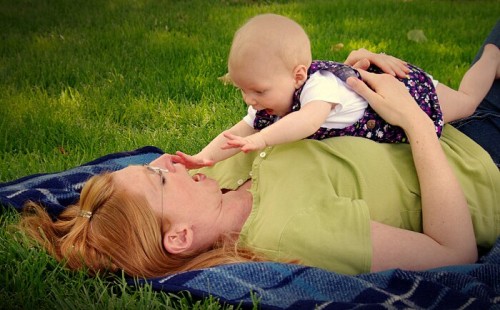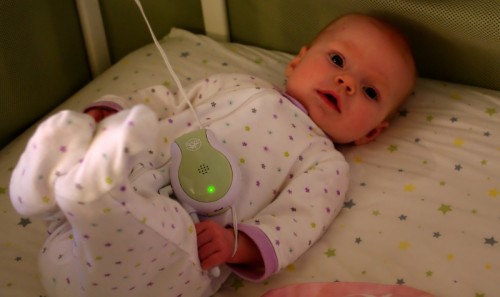Heather turned 6 months old on April 28th. Overall, I would say that things are getting much better. She’s less cranky during the day and she’s sleeping better. We even have a schedule! (Yes, I am ridiculously pleased by this. My life once more has order and predictability! Huzzay!) Our typical day goes roughly like this:
Between 6 and 7am—wake up
7am—nurse
8:30am—feed cereal (barley or oatmeal mixed with prune juice and applesauce)
9-10am—nap
10:30am—nurse
12:45pm—nurse (I’m thinking about changing this to another feeding of solids at some point)
1-2pm—nap
3pm—nurse
4:30pm—feed some variety of fruit/vegetable (squash, sweet potato, pears, peas)
4:45pm—bath (if it’s a bath day)
5:15pm—nurse
5:30pm—storytime with Daddy (I read to her before her naps, too)
6pm—bedtime
Between 2 and 3 am—nurse (as of this last week, this feeding is going away)
All the in-between times are filled, of course, with playing and such. We usually make a circuit between the playmat, the exersaucer thingie, the bouncer, the floor with toys, and sometimes the high chair with toys. Sometimes she’ll play by herself, but she really prefers to have me or Kyle hanging out right there with her. I usually take her on a walk in the afternoon, but it’s been really hot…we’ll see how that goes this summer.
Heather is getting to be a lot of fun and growing her own personality. Sometimes she’ll be very serious, and look around with her brow furrowed, as if she’s not sure her surroundings are quite up to snuff. But then she’ll break out into a huge smile, start throwing her hands around, and make the goofiest noises. Here’s some info about her:
Nicknames: Bug, Drgn, Goober, Bug-a-boo, Bug-a-bug,
Squirmington, Lady Heatherington Fusspants
Favorite Books (she LOVES storytime!): Snuggle Puppy, Babes of the Wild, Stanley & Rhoda
Favorite Songs: “Baby Mine,” “Slippery Fish” (or anything with hand actions), “Hard Scrabble Harvest”
Favorite Toys: Taggies blanket, an empty vitamin bottle (she chews on the dropper squeezer part, and I put some rice in it so it rattles a bit), links, pacifier (she’s getting pretty good at getting it into her mouth properly, but then she often pulls it back out and starts over again)
Favorite Activities: playing on the bathroom counter, going for walks (either in her stroller or the carrier, which she has just started to love)
Heather had her 6-month checkup on the 30th, and she’s doing great! She weighed in at 13.5 lbs, putting her up in the 9th percentile. This made me extremely happy. Guess those solids are really helping!
Heather really likes to be outside. All of these pictures (except the first one) were taken at a little park area across the street. She enjoys laying on the blanket and watching the treetops, but she also loves to watch the cars go by. So if she gets cranky, I will often take her for a walk. The change of scenery usually calms her right down.
She’s currently working on two major skills: sitting and crawling! She can sit, but somebody/thing has to support her so she doesn’t tip over. And she’s getting better and better at pulling her knees up under her (preparatory to crawling). So far, though, she just rocks; she hasn’t made any attempt to move from that position yet. But I bet it won’t be long!
And yes, she likes to put her fingers in my mouth. Best game in the world.





